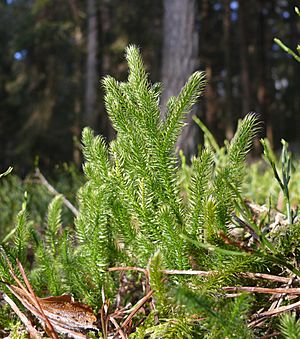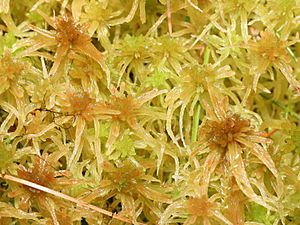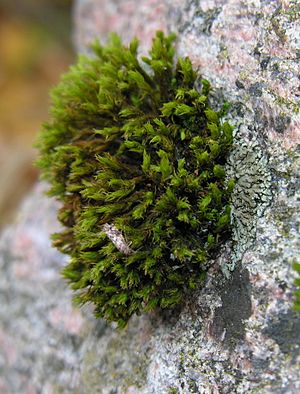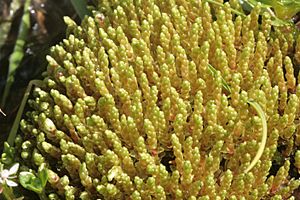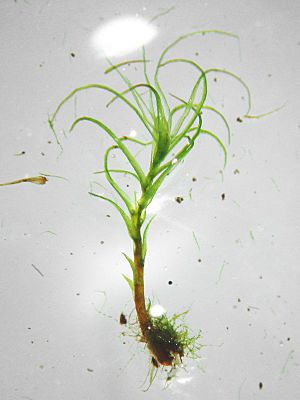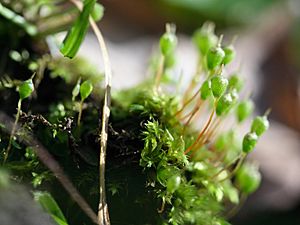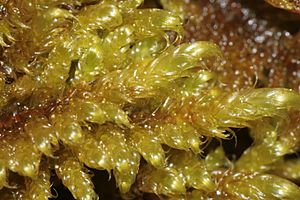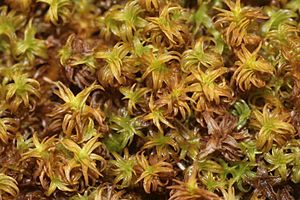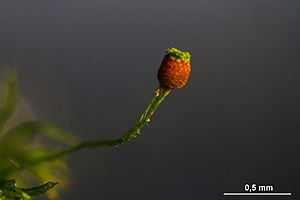List of clubmosses and mosses of Montana facts for kids
Did you know that the state of Montana is home to many cool and ancient plants? There are at least 23 different kinds of clubmosses and 153 types of mosses found there! Some of these plants are even considered "species of concern" by the Montana Natural Heritage Program. This means they might need special protection to make sure they keep growing in Montana.
Contents
Clubmosses: Ancient Green Plants
Clubmosses are really interesting plants. Even though they have "moss" in their name, they are not true mosses! They are actually very old plants, like ferns, and they reproduce using spores instead of seeds. They often look like tiny trees or creeping vines on the forest floor.
Different Kinds of Clubmosses
Clubmosses belong to the plant group called Lycopodiopsida. In Montana, you can find several types:
- True Clubmosses: These are part of the Lycopodiales order. They often have stems that creep along the ground or stand upright, looking like miniature trees.
- Alpine clubmoss, Diphasiastrum alpinum
- Common clubmoss, Lycopodium clavatum
- Stiff clubmoss, Spinulum annotinum
- Tree groundpine, Dendrolycopodium dendroideum
- Quillworts: These unique plants are in the group Isoetopsida. They usually grow underwater or in wet, muddy places. Their leaves look like long quills.
- Bolander's quillwort, Isoetes bolanderi
- Spiny-spored quillwort, Isoetes echinospora
- Spike-mosses: Also in the Isoetopsida group, spike-mosses are often smaller and more delicate than true clubmosses. They can form dense mats on the ground.
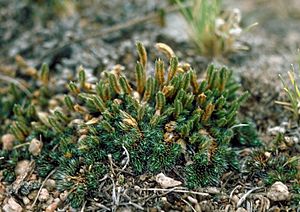
-
- Lesser spikemoss, Selaginella densa
- Wallace's spikemoss, Selaginella wallacei
Mosses: Tiny Green Carpets
Mosses are small, soft plants that often grow in dense clumps or mats, like a green carpet. Unlike clubmosses, they don't have true roots, stems, or leaves. They absorb water and nutrients directly from the air and rain. They are also very old plants and reproduce using spores.
Main Groups of Mosses
In Montana, you can find many different kinds of mosses, each with its own special features.
- Granite Mosses: These mosses (from the group Andreaeopsida) are special because they often grow on rocks, especially granite.
- Blytt's andreaea moss, Andreaea blyttii
- Peat Mosses: These are part of the Sphagnopsida group and are very important for forming peat bogs. They can hold a lot of water, like a sponge!
-
- Flat-topped bogmoss, Sphagnum fallax
- Low sphagnum, Sphagnum compactum
- Rusty peat moss, Sphagnum fuscum
- Haircap Mosses: These mosses (from the group Polytrichopsida) often have tall, stiff stems and look a bit like tiny brushes or hair.
- Northern haircap, Polytrichum sexangulare
- True Mosses: This is the largest group of mosses, called Bryopsida. They come in many shapes and sizes and grow in all sorts of places, from forests to rocks.
-
- Feather Mosses: Many true mosses are called "feather mosses" because they have a soft, feathery look.
- Pointed spear-moss, Calliergonella cuspidata
- Scorpidium moss, Scorpidium scorpioides
- Long-beaked water feathermoss, Platyhypnidium riparioides
- Matted feather moss, Brachythecium populeum
- Feather Mosses: Many true mosses are called "feather mosses" because they have a soft, feathery look.
-
- Bryum Mosses: These are a very common type of moss.
-
-
- Alpine bryum moss, Bryum alpinum
- Arctic bryum moss, Bryum arcticum
- Schleicher's bryum moss, Bryum schleicheri
-
-
- Fork Mosses: These mosses often have leaves that look like tiny forks.
-
-
- Dicranella moss, Dicranella palustris
- Silky forklet moss, Dicranella heteromalla
-
-
- Bladder Mosses: These mosses are known for their unique spore capsules that can look like tiny bladders or pears.
-
-
- Common bladder moss, Physcomitrium pyriforme
- Rusty cord-moss, Entosthodon rubiginosus
-
-
- Dry Rock Mosses: These mosses are tough and can grow in dry, rocky places.
- Britton's dry rock moss, Grimmia brittoniae
- Curved dry rock moss, Grimmia incurva
- Dry Rock Mosses: These mosses are tough and can grow in dry, rocky places.
-
- Hypnum Mosses: These mosses often form dense mats and are common in many habitats.
-
-
- Hypnum moss, Hypnum callichroum
- Recurved hypnum moss, Hypnum recurvatum
-
-
- Hump Mosses: These mosses often grow in wet, boggy areas.
- Short-tooth hump-moss, Amblyodon dealbatus
- Three-ranked hump-moss, Meesia triquetra
- Hump Mosses: These mosses often grow in wet, boggy areas.
-
- Didymodon Mosses: These are common mosses that can grow in many different environments.
-
-
- Didymodon moss, Didymodon brachyphyllus
- Didymodon moss, Didymodon ferrugineus
-
-
- Luminous Moss: This moss is super cool because it glows! It has special cells that gather light, making it look like it's shining in dark caves or crevices.
-
-
- Luminous moss, Schistostega pennata
-
-
- Dung Mosses: Some mosses, like these, grow on animal waste. It might sound strange, but it's a natural part of their life cycle!
- Acuminate dung moss, Tayloria acuminata
- Pinkstink dung moss, Splachnum sphaericum
- Dung Mosses: Some mosses, like these, grow on animal waste. It might sound strange, but it's a natural part of their life cycle!
These are just a few examples of the many amazing clubmosses and mosses you can find in Montana! They play an important role in their ecosystems, helping to prevent erosion and providing homes for tiny creatures.



